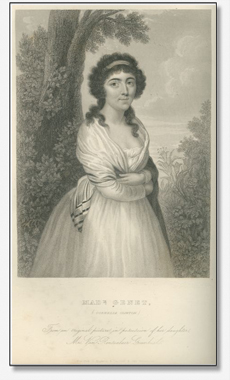
Rufus W. Griswold, The Republican Court, or, American Society in the Days of Washington. New and rev. ed. (New York, 1856), plate opposite 295. First ed., 1855.
CORNELIA TAPPEN CLINTON GENET (1774-1810) Cornelia Tappen Clinton was born in New Windsor, New York, the second daughter of George and Cornelia Tappen Clinton.[1] Her mother was from a prominent Dutch family in New York, and her father would first serve multiple terms as the governor of the state of New York and then as vice president of the United States under Thomas Jefferson.[2] Cornelia grew up in a strong pro-American household and at an early age she took a position on political events. Abigail Adams Smith, the daughter of John and Abigail Adams, observed that even at fourteen years old Cornelia was as “smart and sensible a girl as I ever knew: a zealous politician and a high anti-Federalist.”[3] Although few records survive regarding Cornelia, she, like other women of her time, used her personal influence rather than political power to shape the unfolding history of the country. “Notwithstanding your worth,” she wrote to Edmond Charles Genet (1763-1834), whom she would later marry, “I do not think I could have been attached to you had you been anything but a Republican [and I] support that character to the end as you have begun, and let what may happen….”[4] Cornelia met “Citizen” Genet, the French minister to the United States, at one of the receptions hosted by her father during his tenure as governor:
Cornelia and her husband initially lived on a farm near New York City in Jamaica, Long Island.[6] In 1802, the Genets moved to East Greenbush, New York, to be closer to Cornelia’s family living across the Hudson River in Albany.[7] She died at the early age of thirty-five in 1810, which was a “severe blow” to her father, and is buried in the graveyard of the Greenbush Reformed Church.[8] Written by Janet Hallahan. [1] John P. Kaminski, George Clinton: Yeoman Politician of the New Republic (Madison: Madison House, 1993), 16-17. [2] United States Senate, “George Clinton, 4th Vice President (1805-1812),” http://www.senate.gov/artandhistory/history/common/generic/VP_George_ [3] Rufus W. Griswold, The Republican Court, or American Society in the Days of Washington (New York: D. Appleton & Co., 1867), 95. [4] Linda K. Kerber. 1987. “‘History Will Do It No Justice’: Women’s Lives in Revolutionary America,” (lecture, University of Iowa, 1987), http://sdrc.lib.uiowa.edu/preslectures/kerber87/speech.html (accessed October 13, 2008). [5] Kaminski, George Clinton, 240. [6] Ibid., 250-51. [7] The Legislative Gazette, “East Greenbush History: Citizen Edmond Genet,” November 8, 2004, http://www.legislativegazette.com/special_reports/EastGreen.pdf (accessed October 14, 2008). [8] Ibid.; Kaminski, George Clinton, 249. |

